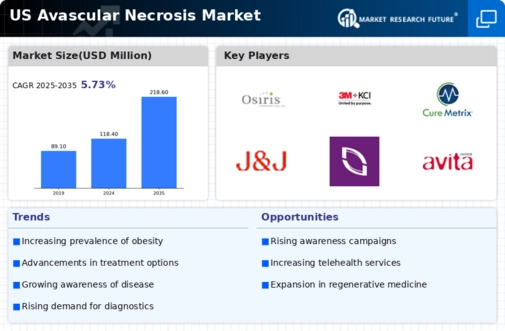Rising Healthcare Expenditure
Rising healthcare expenditure in the US is a significant driver for the avascular necrosis market. As healthcare budgets expand, there is an increased focus on providing comprehensive care for chronic conditions, including avascular necrosis. The US healthcare spending is projected to reach approximately $6 trillion by 2027, which may lead to enhanced funding for research, treatment options, and patient education initiatives. This increase in expenditure could facilitate better access to advanced therapies and improve patient outcomes, thereby stimulating growth in the avascular necrosis market. Furthermore, as more resources are allocated to managing chronic diseases, the market may see a rise in innovative treatment modalities and supportive care services.
Increasing Incidence of Risk Factors
The avascular necrosis market is experiencing growth due to the rising incidence of risk factors associated with the condition. Factors such as prolonged corticosteroid use, excessive alcohol consumption, and certain medical conditions like lupus and sickle cell disease contribute to the development of avascular necrosis. In the US, it is estimated that approximately 10,000 to 20,000 new cases are diagnosed annually, which underscores the need for effective treatment options. As awareness of these risk factors increases, healthcare providers are more likely to screen at-risk populations, thereby driving demand for therapies and interventions in the avascular necrosis market. This trend suggests a potential for market expansion as more individuals seek diagnosis and treatment.
Technological Innovations in Imaging
Technological advancements in imaging techniques are significantly impacting the avascular necrosis market. Enhanced imaging modalities, such as MRI and CT scans, allow for earlier and more accurate diagnosis of avascular necrosis. These innovations facilitate the identification of the condition in its initial stages, which is crucial for effective treatment. The US market has seen a rise in the adoption of these advanced imaging technologies, leading to improved patient outcomes and increased demand for related therapeutic interventions. As healthcare facilities invest in state-of-the-art imaging equipment, the avascular necrosis market is likely to benefit from a surge in diagnosed cases, thereby driving growth in treatment options and patient management strategies.
Enhanced Patient Education and Support Programs
Enhanced patient education and support programs are emerging as a crucial driver in the avascular necrosis market. As healthcare providers recognize the importance of informed patients, initiatives aimed at educating individuals about the condition, its risk factors, and treatment options are becoming more prevalent. In the US, various organizations are developing resources to empower patients, which may lead to earlier diagnosis and treatment. This proactive approach not only improves patient engagement but also encourages individuals to seek medical advice sooner, potentially increasing the demand for therapies in the avascular necrosis market. As awareness grows, the market is likely to benefit from a more informed patient population actively seeking effective management strategies.
Growing Demand for Minimally Invasive Procedures
The avascular necrosis market is witnessing a shift towards minimally invasive procedures, which are becoming increasingly preferred by both patients and healthcare providers. Techniques such as core decompression and stem cell therapy are gaining traction due to their reduced recovery times and lower complication rates compared to traditional surgical methods. In the US, the market for minimally invasive orthopedic procedures is projected to grow at a CAGR of around 8% over the next few years. This trend indicates a potential increase in the number of patients seeking these innovative treatment options, thereby driving the avascular necrosis market as more individuals opt for less invasive solutions to manage their condition.




















Leave a Comment